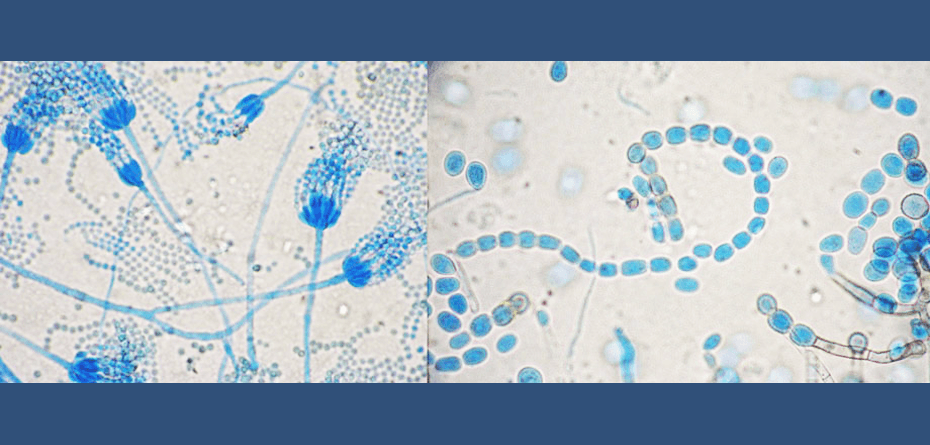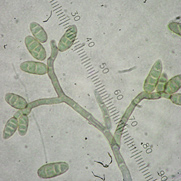
There are several mold types in homes. Many people define mold types by their colour that is: ‘black mold‘, ‘white mold’, ‘green mold’, ‘grey mold’ or ‘brown mold’, or, even more general, ‘black mold’ versus ‘non-black mold’. Unfortunately, the colour of a mold rarely tells you anything useful: there are harmful and non-harmful kinds of mold in each colour group. It is difficult to impossible to determine if a mold is harmful based on how it looks like growing on a surface.
Exposure to all mold types in homes is potentially harmful to humans or animals. Exposure occurs through inhalation of mold spores. Mold spores contain allergens, irritants, and in some cases, toxins that may trigger adverse reactions in humans. The types and severity of symptoms depend, in part, on the mold types present, the extent of an individual’s exposure, the ages of the individuals, and their existing sensitivities or mold allergies. There is a direct correlation between indoor mold exposure and human disease. However, under normal circumstances, most mold types and levels are not harmful to healthy individuals. The problem arises when molds grow indoors and their numbers increase to levels that can become harmful. Long-term exposure to mold or developed sensitivity to certain types of mold may cause or worsen conditions such as asthma, hay fever, or other allergies. The most common symptoms of mold exposure are cough, chest or sinus congestion, runny nose, eye irritations, and aggravation of asthma. Mold exposure has also been linked to sick building syndrome (sbs) and other mold allergy symptoms. There are mold types that are actually beneficial such as in the making of cheese and others used for medicinal purposes such as penicillin.
There are a number of mold types in homes that are either black or grey in color. These include Cladosporium, Pithomyces, Stemphydium, Ulocladium, Aureobasidium, Alternaria, and Stachybotrys. Stachybotrys is known to produce mycotoxins, which produce a potential exposure hazard when infested materials are disturbed. Stachybotrys infestations typically only occur on repeatedly wetted materials that contain cellulose. These include the paper on gypsumboard, cardboard, ceiling tile, cellulose insulation, wood, and other organic materials.
This page help you understand the more common molds out there and their associated hazard classes. A test from a qualified laboratory can determine whether a mold is known to be toxic or not. Mold removal or mold remediation methods are the same regardless of the type of mold. For instructions on how you can collect samples and send them to a lab click How To Sample For Mould Using Clear Scotch Tape. Remember!. It’s the types of mold and the amounts that you inhale that matters. Consider testing air in your home. For instructions on how to test air click How To Sample Air For Total Fungal Spore Counts. You may also be interested to read Frequently Asked Mould Questions.

Hazard Classes of Mold Types in Homes
Some countries have adapted a hazard class system to place molds in different categories based on their health risks. They are broken into Hazard classes A, B and C:
- Hazard Class A:
The mold types in this group are either directly hazardous to health due to risk of infection or creation of toxins. They should not be in homes or workplaces and should be removed right away if found. - Hazard Class B:
The mold types in this group can cause allergic reactions, especially over longer periods of time. - Hazard Class C:
The mold types in this group aren’t known to cause any health risks or reactions in humans. Note, however, that even molds in this category can potentially cause structural damage to things that they are growing on, and should still be gotten rid of.
Some Common Indoor Mold Types in Homes
This is a short list of the more common molds that grow in households. Since molds are incredibly diverse, even within the individual species, it isn’t a complete picture, but it may help in explaining why ‘black mold’ isn’t synonymous with ‘dangerous’.
Cladosporium
(pronounced ‘clad-oh-spore-ee-um’)
Cladosporium is a very common mould. It can appear green, brown, grey or black on surfaces. It is classified as either Hazard Class B or C, depending on the species – i.e., allergic reactions are generally the only concern with Cladosporium. It can grow in many places, including walls, wood, dust, and insulation.
Aspergillus
(pronounced ‘as-per-jill-us’)

Aspergillus is another common mold. It can look grey, brown, yellow, green, white, or black. There are many species in the genus, and they generally fall into Hazard Classes A or B. Some can cause infection in people with weak immune systems, and some of them can make toxins in certain circumstances. Others will only cause allergic reactions. Aspergillus can grow on walls, insulation, paper products, soil, clothing, and many other places.
Penicillium
(pronounced ‘pen-ih-sill-ee-um’)
Penicillium is a name that often strikes people as familiar, and that is because modern antibiotics were discovered thanks to a species of Penicillium long ago. However, that doesn’t mean that the genus can’t be hazardous. It can look blue, green, or white, and its species are generally classified as B or C. It can be found on foods, such as cheese and fruit, or in the walls, the insulation, and other places.
Ulocladium
(pronounced ‘you-low-clad-ee-um’)
Ulocladium usually looks black or grey. It falls into hazard classes B and C, and tends to grow in damp areas. It can be found on walls, around windows, in dusty areas, and other places.
Acremonium
(pronounced ‘ack-ri-moan-ee-um’)
Acremonium is often found on insulation and drywall/sheetrock, although it can be found in many other areas, too – it grows in damp places. It can appear white, grey or brown, and various species are found in all three hazard classes.
Stachybotrys
(pronounced ‘stack-ee-bot-riss’)
Stachybotrys is the infamous black mold that made the news in association with ill health effects many years ago. It needs a very damp area to grow, and is considered a Hazard Class A mold, as it can create toxins. It looks black on surfaces.
Alternaria
(pronounced ‘all-ter-nair-ee-uh’)

Alternaria looks similar to Ulocladium under a microscope. It can appear black or grey on surfaces. It is classified as a Hazard Class B mold, and has been known to cause various allergic reactions. It can grow on walls, dusty areas, around windows, damp areas, in soil, on plants, and in various other places.
An important side note is that sometimes what you’re looking at is actually efflorescence rather than mold. This is a deposit of white salts, especially on concrete, where water has penetrated and left a salt deposit on the surface. It can be difficult to tell.
If you want to find out whether you have a hazardous mold, a harmless mold, or just efflorescence or soot, it’s actually very simple, requiring no special equipment. A piece of perfectly clear scotch tape (the cellophane kind, not the ‘magic’ semi-translucent kind), stuck to the mold, will pick up some of the mold the way that it is growing. It should then be stuck to the inside of a ziplock bag and sealed. There are numerous laboratories that are able to identify a mold from a tape sample. Click here to see the different options for mold testing that you can perform yourself and save money.

Leave a Reply
You must be logged in to post a comment.